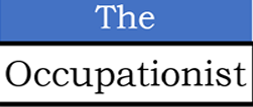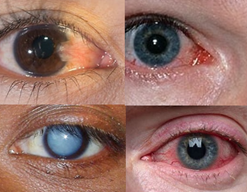Taking care of the eyes and protecting them while working or even otherwise, should not be ignored; not just to prevent injuries but also eye illnesses. At workplaces, the role of OH physician in protecting eye health is of utmost importance.
In USA, around 65,000 work-related eye injuries and illnesses occur every year, causing significant morbidity and disability. The global figures would run in millions and hence having a ‘eye protection program’ is necessary just as a ‘hearing conservation program’ to protect hearing in a high-noise industry is necessary.
We work everywhere, in conditions that apparently look safe to obviously unsafe. Working with computers may appear safe but has an impact on eye health. On the other hand, a welder’s job is obviously unsafe to the eyes due to high-intensity light produced while welding.
In contrast to an eye injury that happens instantaneously, eye illnesses happen insidiously (slowly, taking few hours to days, weeks or even more) to develop and cause damage.
Contact lenses do not provide eye protection, and Occupational Health physicians should step in and provide guidelines for the use of proper eye protection at the workplace.
In this article brief insight is given into some of the places, equipment or job types that can cause eye illnesses, and steps that if taken can mitigate the risk to ALARP (as low as reasonably practicable).
Working indoors: Laptops are used on an average for 6-8 hours and often almost continuously as a result the eyes do not get the rest they should. Eye fatigue and dry eyes occur due to prolonged staring at the computer, and it can be prevented by taking frequent breaks for 2-3 minutes, forcing yourself to blink the eyes periodically, closing your eyes in between and looking at distant objects.
Incorrect illumination and glares are other factors that can cause eye strain and vision abnormalities in left uncorrected. Simple steps can improve illumination and block glares.
Working outdoors: Construction workers, farmers, fishermen, salespersons, sports enthusiasts and others who spend time outdoors are exposed to ultraviolet (UV) light. Proper sunglasses that can block UV radiation help protect the eye, else in the long and short-term exposure can harm the eyes, affect vision, and compromise overall eye health. While cataract and eye cancers take a long time develop due to UV exposure, growths in the eyes such as pterygium develops earlier. Snow blindness, a form of photokeratitis, develops quickly after exposure to UV reflections from snow, ice, sand, or water.
Working with an equipment: Welding machine is one such frequently used equipment that creates high-intensity light (both ultraviolet and infrared) harmful to eyes. Welders should be mindful of this and use proper eye protection as it has both long term and short-term damage to eyes. Welding impacts the iris of the eyes and compromises the ability of the eyes to close sufficiently and rapidly enough to limit the brightness of the light reaching the retina. This results in the light temporarily blinding and fatiguing the eyes. Photokeratitis, cataract, pterygium and AMD (Age-related macular degeneration) are cause by such exposures during welding. High UV exposure at a younger age has been significantly associated with early AMD. Photokeratitis (sunburn of cornea) takes a few hours to develop during welding with unprotected eyes and causes redness and pain in the eyes by the evening. If the eyes have received enough UV rays to burn your corneas, you just added another dose of UV rays to the total accumulation your eyes have received to date.
Working in food industry: Work-related allergic conjunctivitis is being increasingly recognized in workers handling food due to exposure to smoke, spices, fruits and vegetables. Use of eye protecting goggles helps in reducing the exposure.
Working in agriculture industry: Farmers are exposed exposure to chemicals (pesticides) and plants, and these can have an impact on eye health in the form of chemical conjunctivitis or allergic conjunctivitis. Use of goggles and modern spraying methods that reduce exposure to chemicals, especially pesticides must be used. Goggles will also reduce exposure of the eyes with plants.
As use of laser increases in the industry and medical settings, proper eye protection is necessary to prevent cataracts.
Cataracts are the most common cause of vision loss in people over 40. A cataract is defined as the progressive clouding of the lenses of the eyes. Left untreated they are ranked globally as a primary cause of reversible blindness.
WHO (World Health Organization) estimates that up to 20 percent of all cataract cases are attributable to UV radiation and are preventable. Around three million surgeries to remove cataracts are performed in the U.S. annually, of the estimated 20 million Americans who have cataracts.
According to the American Academy of Ophthalmology, an estimated 90 percent of eye illnesses and injuries are preventable with the use of proper safety eyewear.
Whenever there is risk to eye health, short-term or long-term, it is important to consider eye protection not only of the worker doing the job but of coworkers or anyone.
Contact lenses do not provide eye protection, and Occupational Health physicians should step in and provide guidelines for the use of proper eye protection at the workplace. In fact, OH physicians should develop a robust eye protection program in industries they have access to.
To know more, MSMEs and large corporation may contact
_________________________________________________________________________________________________________
Dr Ajay Sati is an Occupational Health physician who prefers to describe himself as an Occupationist, to denote, ‘an expert in diseases and other concerns of occupations’. Dr Sati has managed health and wellness programs in industries he worked, like the atomic energy, and energy (oil & gas) in India and overseas. He was involved in many greenfield and brownfield projects providing inputs from health point of view. Known for SOPs and protocols, he is currently involved with an energy MNC in designing protocols to support employees during the covid pandemic, and protocols to safely reopen offices and plants.



